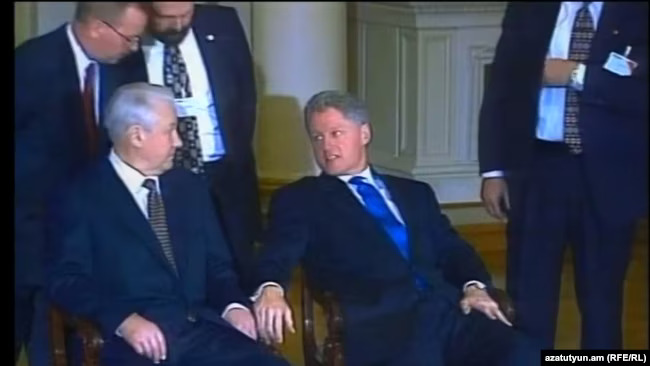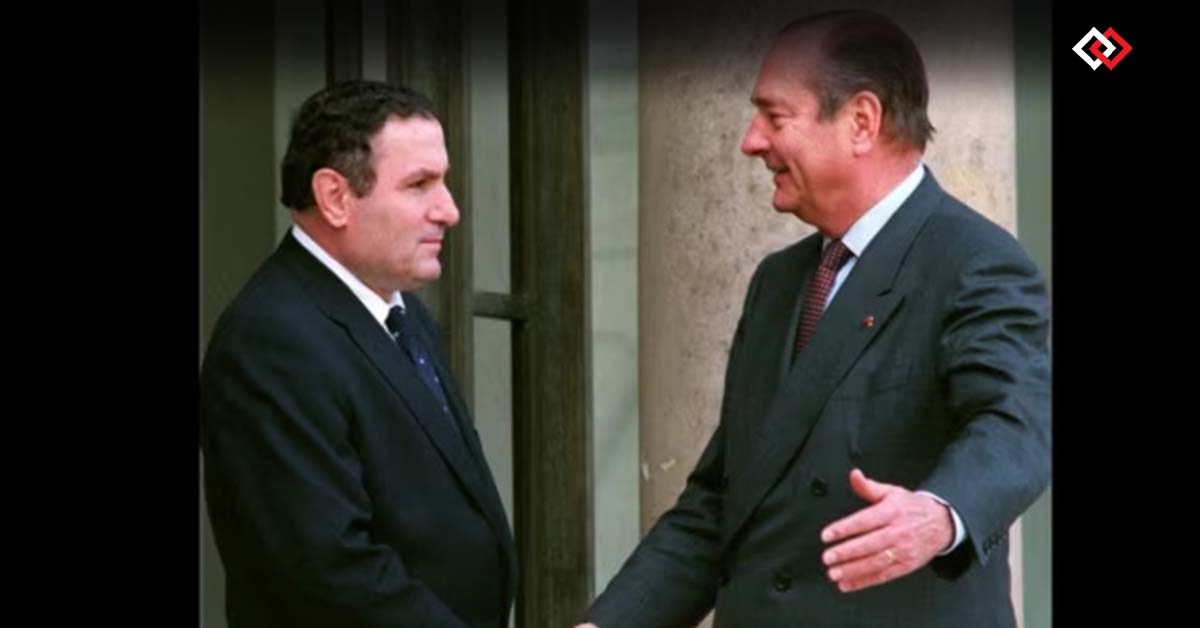Declassified State-Department documents
Below extracts from the Azatutyun’s “Ter-Petrosyan’s 1997 resignation” article, including insightful US state department documents.
The recently declassified documents come to confirm that the 2020 war was lost in 1997 due to one person’s lack of insightfulness, which as of then, marginalized Armenia.
Indeed, had peace been achieved in 1997, today Armenia would be the crossroad of energy pipelines, with a complete different economic and geopolitical stature.
Exactly 25 years ago, on February 3, the first president of independent Armenia, Levon Ter-Petrosyan, submitted his resignation, noting that such a demand was put before him by the known forces.
The negotiation process over the Artsakh Issue started to become active one year before Ter-Petrosyan’s resignation, in 1997. There were two contributing factors. First, Azerbaijan had begun to sign the first agreements on installing gas and petroleum pipelines, and the West was interested in establishing stability and peace in the region. On the other hand, in January of the same year, a new format was established: Russia, the United States and France co-chairmanship. As the diplomatic telegraphs of the State Department testify, at that stage, it was in the interest of all three parties to settle this issue and thereby show that the West and Russia could cooperate and contribute to the peace of Europe.
In February, American Deputy Secretary of State Strobe Talbott meets the Armenian Foreign Minister Alexander Arzumanyan and asks to convey to President Ter-Petrosyan that three superpowers are now dealing with Artsakh Issue; this is a fact that should not be ignored.
All three parties emphasise that they are ready to act as one front and intensify the pressure, so the conflicting sides make concessions. It is decided to include the issue on the agenda of the Yeltsin-Clinton meeting to be held a month later, in April, in Helsinki. The President of the United States launches the discussion of the issue during the working lunch.

Two weeks after that, the three negotiators meet in Washington and, for the first time, combine their ideas, drawing up a single document.
After a couple of days, that document is discussed and adopted at the level of the presidents, during the Paris meeting of Clinton, Yeltsin and Chirac.
At the end of May, mediators already bring that document, which later became known as the “Packaged Resolution”, to the region. From the first minutes of the meeting with the President of Armenia to the last moment, the envoys emphasise the same idea: they are united and serious.
“The three countries, from the presidents to their governments, have worked hard to advance the peace process with full responsibility”, according to the declassified document, says the US Deputy State Secretary to Ter-Petrosyan, emphasising that “the international community expects the parties to respond to their efforts with due seriousness”.
Then the leaders of the United States, Russia and France, in their turn, at the “Great Eight” summit in Denver, adopt the first joint statement on Artsakh Issue.
“Cease fire is not enough by itself. The international community urges to reach a final settlement, and we are convinced that the establishment of stable and lasting peace in the region should not be delayed”, declared Yeltsin, Clinton, and Chirac.
Having met State Secretary Albright in Denver, the Russian Foreign Minister proposes to use threats and sanctions. “You, Americans, can do something with the Azeris using petroleum as leverage. You can say that if things do not work out, you won’t encourage your companies to help Azerbaijan in petroleum production. As for Armenia, we will use weapons as leverage. In other words, Russia can threaten Armenia not to give weapons, and you can advance the petroleum factor”.
Despite these warnings, Stepanakert and Baku categorically reject the “Packaged Resolution”. In about two months, the co-chairs present the new “Phased Resolution”, based on the same principles, on an extended implementation plan. In particular, if the first plan, the “Packaged Resolution”, assumed that the return of the territories and the determination of the status should take place simultaneously, now the mediators propose to first liberate the territories, return the refugees, ensure the security and self-government of Artsakh, and then address the issues of the territorial integrity of Azerbaijan and the status of Artsakh.
In light of these consistent efforts of the co-presidents, the President of Armenia convenes a press conference in September and emphasises how dangerous it is for the Armenian side to go against the will of the international community: “What do think, is the international community going to allow this situation to be maintained for 20 or 30 years time?” It is excluded, and the international community will find means to impoverish us so much that we will not only be unable to achieve what we can achieve today through compromises, but will also be in a much worse situation.
After Ter-Petrosyan’s press conference, mediators start discussing how to convince Stepanakert. French President Jacques Chirac, having met the Armenian President in Strasbourg in October, offers to invite the new Prime Minister Kocharyan and other influential Artsakh politicians to Paris.
“The goal is to pressure them to come to an agreement. Then Kocharyan can be invited to Moscow, then to New York, where he will be told the same thing”, the French Deputy Foreign Minister suggests to the US Deputy State Secretary, according to the declassified documents.
The idea, however, does not yield any results. After Kocharyan’s visit, the Deputy Foreign Minister of France sent a secret telegram to Washington: “We did not manage to achieve any real change in Kocharyan’s positions, and we do not see any real prospect of starting negotiations”.
Trying to explain the phenomenon of sharply rejecting the international community, the mediators even assume that Ter-Petrosyan and Kocharyan are playing a concerted game: one rejects the mediators, and the other declares that he is ready for compromises.
The diplomats decide to meet again in Paris in a few days. Until then, two weeks after the Primakov-Talbott conversation, Ter-Petrosyan resigns.
“I refrain from any comments or assessments to avoid aggravating the situation. I only consider it necessary to mention that discussing Artsakh Issue was just an excuse for the governance crisis. The issue is much deeper and related to the principles of statehood and the alternative of peace and war. In the end, life will show who has achieved anything for Artsakh, and who is actually selling it”, the first president said in his speech.
On those days, the proposed resolution was offering to withdraw the Armenian forces from the occupied territories, except for Lachin, to create a dividing line between the parties – a buffer zone, which should remain completely uninhabited and under the control of the OSCE forces. The Lachin Corridor was supposed to be 22 km instead of today’s 5 km, and Azerbaijan had to lease it to the OSCE, which in turn had to hand it over to the Artsakh authorities.
Artsakh should have had its own flag, coat of arms, anthem and constitution. Citizens could have served in the military on the territory of Artsakh, and the Azerbaijani army, security forces and police would not have the right to enter Artsakh without the permission of the local authorities. Stepanakert also would have received the right to establish external relations with foreign countries and international organisations in the fields of economy, science, culture, sports and humanitarian issues. After these steps, in the next phase, it was suggested to move on to clarifying the status. Also, the international community was promising to deploy peacekeeping forces, to guarantee security.
Diplomatic documents show that in closed-door negotiations on the issue, mediators repeatedly emphasise that this was the best they could think of, and the best they could offer the parties. At the same time, the superpowers warned the Armenian side that by not reaching a solution, Armenia would lose opportunities for development and prosperity.
“1997 is the year to make a decision on gas pipelines and transport lines. Suppose the Armenian side will not be able to participate in the regional developments. In that case, its consequences will be expensive for Armenia, which is not in anyone’s interest”, warned James Collins, the American Ambassador with Special Assignments, to the Armenian Foreign Minister months before that.
Deputy State Secretary Srtob Talbot also emphasised that Armenia’s participation in energetic and regional projects depends on the settlement of the Artsakh Issue.
After the resignation of the first president, for more than two decades, all three leaders of Armenia adopted the policy of maintaining the Status Quo. All three accused Ter-Petrosyan of defeatism and betrayal at different phases of their rule.




